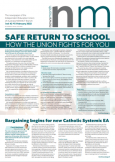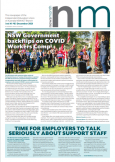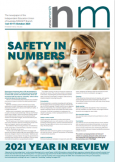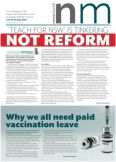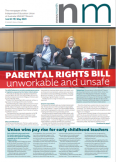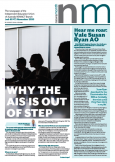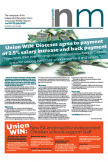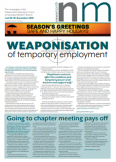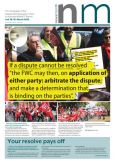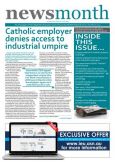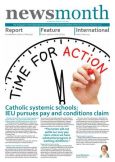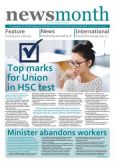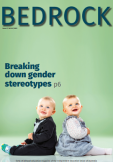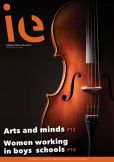
At midday on Friday 24 April after more than 380 days of, at times, bitter dispute with Catholic employers, a significant development occurred that encouraged the Union to suspend industrial action planned for the following Tuesday.
The dispute commenced on 7 April 2014 when CCER hand delivered the draft of a totally unacceptable enterprise agreement (EA) to the Union’s office.
Claiming their proposal was to start a conversation, it did much more than that, uniting IEU members as seldom before against what they rightly saw as an attack on wages, working conditions and job security.
Twelve months on and very little of that document remains and what does has been tempered by modifications, protections and acceptable levels of compensation. It will provide significant advantage to IEU members throughout NSW and the ACT.
The EA we are now seeking to assemble will cover teachers and support staff as well as outdoor and maintenance staff in NSW and the ACT. A single agreement to replace seven existing ones.
This ambitious task is not without its challenges. More so when the original proposal was to strip conditions and establish a lowest common denominator minimalist industrial instrument.
For more than 12 months members have made their opposition clear, first by voting overwhelmingly in a series of protected action ballots, the largest number of such ballots on a single issue since the Fair Work laws were established.
Members then began to take the action they had endorsed by wearing red, displaying badges and taking stop work action not once but twice. Employers, despite significant efforts in some cases, were powerless to stop members exercising the rights they had won in the ballot process.
The threat of a full day of industrial action finally focused the attention of employers on resolving the impasse that existed with many of the significant but outstanding matters and, following a series of meetings, they offered the Union a revised ‘terms of settlement’. While not all issues are fully settled the IEU, as an act of good faith, suspended the planned action.
Good outcomes
During the past year through countless hours of negotiations the Union has piece-by-piece reassembled key parts of the existing EA. Returning promotions positions, maintaining the status quo in respect of work practice agreements (thus preserving class size limits and hours of work) and reversing the proposed cuts to new support staff wages have all been achieved. Lunch breaks of 30 continuous minutes and fair procedures will continue as features of any new agreement and support staff required to perform higher duties to cover for an absent colleague will continue to be paid the higher rate, as they currently are.
Pay increases
The key features of the agreement we are working towards will deliver the modest wage and salary increases in line with Government outcomes: 2.27% from January 2015 and 2.5% from the beginning of 2016 in NSW. Teachers in the ACT will receive 1.5% increases each October and April from 2014.
New pay structure
There will be a new salary structure for teachers that over time will compress the nine incremental steps to seven. These are divided into Graduate (2 Steps) and Proficient Teacher (5 Steps).
Teachers will transition to this new model over the next few years and in the meantime most will continue on the current scale towards Step 13 (Proficient level 5). A fuller explanation will be provided shortly.
Support staff will also move across to new classifications. No one is to be disadvantaged by these processes.
Personal and carer's leave
Proposed changes to the quantum of personal/carer's leave do not impact on support staff however changes to the evidence requirements and the introduction of special family leave will be an immediate benefit for both them and for teachers.
Reducing the annual quantum of leave for teachers but removing the cap on accumulation will benefit most teachers immediately and others over time. Currently a full time teacher who has never taken leave can accrue a maximum of 150 days leave (only past six years count). Under the same circumstances that teacher would have 180 days at the end of 2017.
In reality most take some leave and employers say the average is seven days. That ‘average’ teacher who continues to use seven days would move from their current maximum 108 days (only past six years count) to 131 days in 2017.
A teacher with a history of using 10 days would accumulate 110 days by 2017 instead of their current cap of 90 days. Part time teachers will see proportional results.
In the coming weeks the Union will produce a number of models to assist individual to assess their own circumstances. Union officers will be able to assist.
Support for teacher accreditation
Those teachers working towards accreditation at Proficient level and their mentors will have support guaranteed in the agreement although employers have not agreed to match the current time release provided to government teachers in all dioceses. There will be other potential benefits for these ‘Graduate’ teachers as well.
Catholic ethos
The issue of the Catholic ethos remains a contested matter. It should be noted that despite what some employers have said and some continue to say, the IEU has NOT opposed the inclusion of a requirement for staff to support the mission of the Church in Catholic education.
These requirements exist in agreements already in various forms. We have agreed to replace the various existing Catholic ethos clauses with a statement of expectations regarding support (as above) and requirement that employees avoid influence on students contrary to the Church position.
Employers however continue to pursue the right to include additional unspecified requirements. Further discussions are required and will take place over coming weeks.
The Union will provide a comprehensive outline of the new EA and the conditions it covers in coming weeks.
















